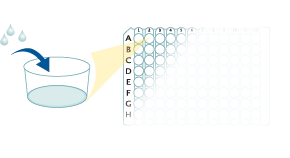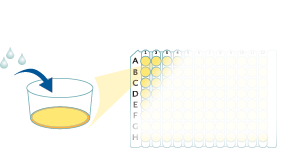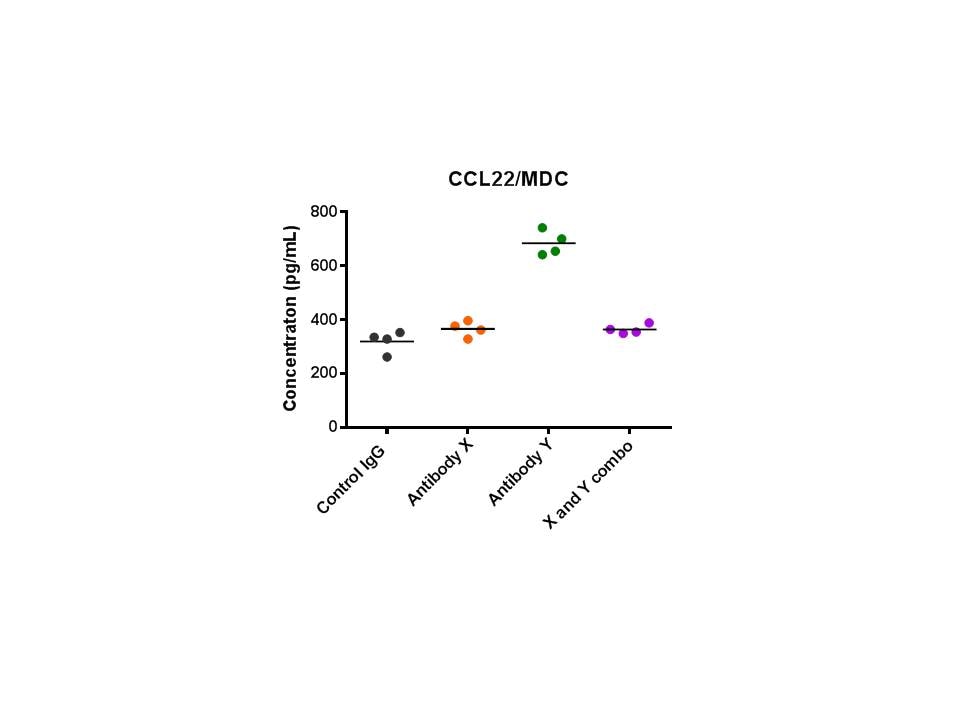Mouse CCL22/MDC Quantikine ELISA Kit Summary
Product Summary
Precision
Cell Culture Supernates, Serum, EDTA Plasma, Heparin Plasma
| Intra-Assay Precision | Inter-Assay Precision | |||||
|---|---|---|---|---|---|---|
| Sample | 1 | 2 | 3 | 1 | 2 | 3 |
| n | 20 | 20 | 20 | 24 | 24 | 24 |
| Mean (pg/mL) | 19.9 | 51.8 | 382 | 20 | 52.6 | 383 |
| Standard Deviation | 1.3 | 2.5 | 19.2 | 1.7 | 2.9 | 28.7 |
| CV% | 6.5 | 4.8 | 5 | 8.5 | 5.5 | 7.5 |
Recovery
The recovery of mouse MDC spiked to three levels throughout the range of the assay in various matrices was evaluated.
| Sample Type | Average % Recovery | Range % |
|---|---|---|
| Cell Culture Supernates (n=7) | 102 | 87-112 |
| EDTA Plasma (n=4) | 94 | 89-98 |
| Heparin Plasma (n=4) | 90 | 80-109 |
| Serum (n=5) | 91 | 82-100 |
Linearity
Scientific Data
Product Datasheets
Preparation and Storage
Background: CCL22/MDC
Macrophage-derived chemokine (MDC), also named stimulated T cell chemotactic protein (STCP-1) and ABCD-1, and now designated as CCL22, is a CC chemokine initially isolated from clones of monocyte-derived macrophages. At the amino acid sequence level, MDC shows less than 35% identity to other CC chemokine family members. Human MDC is expressed in dendritic cells, macrophages and activated monocytes. In addition, MDC expression is detected in thymus, lymph node and appendix tissues. At the amino acid sequence level, mouse and human MDC share 64% identity and 83% similarity.
Assay Procedure
Refer to the product- Prepare all reagents, standard dilutions, and samples as directed in the product insert.
- Remove excess microplate strips from the plate frame, return them to the foil pouch containing the desiccant pack, and reseal.
- Add 50 µL of Assay Diluent to each well.
- Add 50 µL of Standard, Control, or sample to each well. Cover with a plate sealer, and incubate at room temperature for 2 hours.
- Aspirate each well and wash, repeating the process 4 times for a total of 5 washes.
- Add 100 µL of Conjugate to each well. Cover with a new plate sealer, and incubate at room temperature for 2 hours.
- Aspirate and wash 5 times.
- Add 100 µL Substrate Solution to each well. Incubate at room temperature for 30 minutes. PROTECT FROM LIGHT.
- Add 100 µL of Stop Solution to each well. Read at 450 nm within 30 minutes. Set wavelength correction to 540 nm or 570 nm.





Citations for Mouse CCL22/MDC Quantikine ELISA Kit
R&D Systems personnel manually curate a database that contains references using R&D Systems products. The data collected includes not only links to publications in PubMed, but also provides information about sample types, species, and experimental conditions.
23
Citations: Showing 1 - 10
Filter your results:
Filter by:
-
Type I interferon antagonism of the JMJD3-IRF4 pathway modulates macrophage activation and polarization
Authors: K Ming-Chin, AA Achuthan, DP De Souza, TJ Lupancu, KJ Binger, MKS Lee, Y Xu, MJ McConville, NA de Weerd, D Dragoljevi, PJ Hertzog, AJ Murphy, JA Hamilton, AJ Fleetwood
Cell Reports, 2022-04-19;39(3):110719.
Species: Mouse
Sample Types: Cell Culture Supernates
-
EBV+ tumors exploit tumor cell-intrinsic and -extrinsic mechanisms to produce regulatory T cell-recruiting chemokines CCL17 and CCL22
Authors: A Jorapur, LA Marshall, S Jacobson, M Xu, S Marubayash, M Zibinsky, DX Hu, O Robles, JJ Jackson, V Baloche, P Busson, D Wustrow, DG Brockstedt, O Talay, PD Kassner, G Cutler
PloS Pathogens, 2022-01-13;18(1):e1010200.
Species: Mouse
Sample Types: Cell Culture Supernates
-
Mechanism of chlorogenic acid in alveolar macrophage polarization in Klebsiella pneumoniae-induced pneumonia
Authors: QR Li, SR Tan, L Yang, W He, L Chen, FX Shen, Z Wang, HF Wang
Journal of leukocyte biology, 2021-09-29;0(0):.
Species: Mouse
Sample Types: BALF
-
Isoalantolactone alleviates ovalbumin?induced asthmatic inflammation by reducing alternatively activated macrophage and STAT6/PPAR?gamma/KLF4 signals
Authors: Y Song, X Li, F Liu, H Zhu, Y Shen
Molecular Medicine Reports, 2021-08-09;24(4):.
Species: Mouse
Sample Types: Cell Culture Supernates
-
Neutralization of IL-33 modifies the type 2 and type 3 inflammatory signature of viral induced asthma exacerbation
Authors: KJ Warren, JA Poole, JM Sweeter, JM DeVasure, JD Dickinson, RS Peebles, TA Wyatt
Respiratory Research, 2021-07-15;22(1):206.
Species: Mouse
Sample Types: BALF
-
A transcription factor PU.1 is critical for Ccl22 gene expression in dendritic cells and macrophages
Authors: T Yashiro, S Nakano, K Nomura, Y Uchida, K Kasakura, C Nishiyama
Sci Rep, 2019-02-04;9(1):1161.
Species: Mouse
Sample Types: Cell Culture Supernates
-
Eosinophil recruitment is dynamically regulated by interplay among lung dendritic cell subsets after allergen challenge
Authors: S Yi, J Zhai, R Niu, G Zhu, M Wang, J Liu, H Huang, Y Wang, X Jing, L Kang, W Song, Y Shi, H Tang
Nat Commun, 2018-09-24;9(1):3879.
Species: Mouse
Sample Types: BALF
-
Sox7 promotes high-grade glioma by increasing VEGFR2-mediated vascular abnormality
Authors: IK Kim, K Kim, E Lee, DS Oh, CS Park, S Park, JM Yang, JH Kim, HS Kim, DT Shima, JH Kim, SH Hong, YH Cho, YH Kim, JB Park, GY Koh, YS Ju, HK Lee, S Lee, I Kim
J. Exp. Med., 2018-02-14;0(0):.
Species: Mouse
Sample Types: Cell Culture Supernates
Applications: ELISA Capture -
Airway inflammation after epicutaneous sensitization of mice requires protease activity of low-dose allergen inhalation
Authors: I Nishioka, T Takai, N Maruyama, S Kamijo, P Suchiva, M Suzuki, S Kunimine, H Ochi, S Shimura, K Sudo, H Ogawa, K Okumura, S Ikeda
J. Allergy Clin. Immunol., 2018-02-06;0(0):.
Species: Mouse
Sample Types: BALF
-
CCL11 promotes migration and proliferation of mouse neural progenitor cells
Authors: F Wang, N Baba, Y Shen, T Yamashita, E Tsuru, M Tsuda, N Maeda, Y Sagara
Stem Cell Res Ther, 2017-02-07;8(1):26.
Species: Mouse
Sample Types: Tissue Homogenates
-
Dendritic cells induce Th2-mediated airway inflammatory responses to house dust mite via DNA-dependent protein kinase.
Authors: Mishra, Amarjit, Brown, Alexandr, Yao, Xianglan, Yang, Shutong, Park, Sung-Jun, Liu, Chengyu, Dagur, Pradeep, McCoy, J Philip, Keeran, Karen J, Nugent, Gayle Z, Jeffries, Kenneth, Qu, Xuan, Yu, Zu-Xi, Levine, Stewart, Chung, Jay H
Nat Commun, 2015-02-18;6(0):6224.
Species: Mouse
Sample Types: BALF
-
Mycoplasma pneumoniae CARDS toxin exacerbates ovalbumin-induced asthma-like inflammation in BALB/c mice.
Authors: Medina, Jorge L, Coalson, Jacqueli, Brooks, Edward G, Le Saux, Claude J, Winter, Vicki T, Chaparro, Adriana, Principe, Molly F, Solis, Laura, Kannan, T R, Baseman, Joel B, Dube, Peter H
PLoS ONE, 2014-07-24;9(7):e102613.
Species: Mouse
Sample Types: BALF
-
Cleavage of the T cell protein tyrosine phosphatase by the hepatitis C virus nonstructural 3/4A protease induces a Th1 to Th2 shift reversible by ribavirin therapy.
Authors: Brenndorfer E, Brass A, Karthe J, Ahlen G, Bode J, Sallberg M
J Immunol, 2014-01-17;192(4):1671-80.
Species: Mouse
Sample Types: Cell Lysates
-
Chitin elicits CCL2 from airway epithelial cells and induces CCR2-dependent innate allergic inflammation in the lung.
J. Immunol., 2012-07-30;189(5):2545-52.
Species: Mouse
Sample Types: Cell Culture Supernates
-
Prevention of murine autoimmune diabetes by CCL22-mediated Treg recruitment to the pancreatic islets.
Authors: Montane J, Bischoff L, Soukhatcheva G, Dai DL, Hardenberg G, Levings MK, Orban PC, Kieffer TJ, Tan R, Verchere CB
J. Clin. Invest., 2011-08-01;121(0):3024.
Species: Mouse
Sample Types: Cell Lysates
-
Dual functions of prostaglandin D2 in murine contact hypersensitivity via DP and CRTH2.
Authors: Yamamoto Y, Otani S, Hirai H, Nagata K, Aritake K, Urade Y, Narumiya S, Yokozeki H, Nakamura M, Satoh T
Am. J. Pathol., 2011-05-10;179(1):302-14.
Species: Mouse
Sample Types: Tissue Homogenates
-
IL-33 and M2a alveolar macrophages promote lung defense against the atypical fungal pathogen Pneumocystis murina.
Authors: Nelson MP, Christmann BS, Werner JL, Metz AE, Trevor JL, Lowell CA, Steele C
J. Immunol., 2011-01-10;186(4):2372-81.
Species: Mouse
Sample Types: Tissue Homogenates
-
CD11b+ myeloid cells are the key mediators of Th2 cell homing into the airway in allergic inflammation.
Authors: Medoff BD, Seung E, Hong S, Thomas SY, Sandall BP, Duffield JS, Kuperman DA, Erle DJ, Luster AD
J. Immunol., 2009-01-01;182(1):623-35.
Species: Mouse
Sample Types: BALF
-
Role of the chemokine decoy receptor D6 in balancing inflammation, immune activation, and antimicrobial resistance in Mycobacterium tuberculosis infection.
Authors: Di Liberto D, Locati M, Caccamo N, Vecchi A, Meraviglia S, Salerno A, Sireci G, Nebuloni M, Caceres N, Cardona PJ, Dieli F, Mantovani A
J. Exp. Med., 2008-08-11;205(9):2075-84.
Species: Mouse
Sample Types: Serum
-
A novel mechanism for CCR4 in the regulation of macrophage activation in bleomycin-induced pulmonary fibrosis.
Authors: Trujillo G, O'Connor EC, Kunkel SL, Hogaboam CM
Am. J. Pathol., 2008-04-10;172(5):1209-21.
Species: Mouse
Sample Types: Tissue Homogenates
-
Allergic pulmonary inflammation in mice is dependent on eosinophil-induced recruitment of effector T cells.
Authors: Jacobsen EA, Ochkur SI, Pero RS, Taranova AG, Protheroe CA, Colbert DC, Lee NA, Lee JJ
J. Exp. Med., 2008-03-03;205(3):699-710.
Species: Mouse
Sample Types: BALF
-
iNKT cells require CCR4 to localize to the airways and to induce airway hyperreactivity.
Authors: Meyer EH, Wurbel MA, Staton TL, Pichavant M, Kan MJ, Savage PB, DeKruyff RH, Butcher EC, Campbell JJ, Umetsu DT
J. Immunol., 2007-10-01;179(7):4661-71.
Species: Mouse
Sample Types: Tissue Homogenates
-
Protection against inflammation- and autoantibody-caused fetal loss by the chemokine decoy receptor D6.
Authors: Martinez de la Torre Y, Buracchi C, Borroni EM, Dupor J, Bonecchi R, Nebuloni M, Pasqualini F, Doni A, Lauri E, Agostinis C, Bulla R, Cook DN, Haribabu B, Meroni P, Rukavina D, Vago L, Tedesco F, Vecchi A, Lira SA, Locati M, Mantovani A
Proc. Natl. Acad. Sci. U.S.A., 2007-02-05;104(7):2319-24.
Species: Mouse
Sample Types: Serum
FAQs
-
Assay Diluent RD1-63 contains visible precipitate. Is this acceptable to use?
A small amount of precipitate is expected and acceptable in Assay Diluent RD1-63. Variability has been observed between vials and diluent lots. It may not fully resolubilize but this will not impact assay performance. It is not recommended to filter the precipitate.
Reviews for Mouse CCL22/MDC Quantikine ELISA Kit
Average Rating: 4 (Based on 1 Review)
Have you used Mouse CCL22/MDC Quantikine ELISA Kit?
Submit a review and receive an Amazon gift card.
$25/€18/£15/$25CAN/¥75 Yuan/¥2500 Yen for a review with an image
$10/€7/£6/$10 CAD/¥70 Yuan/¥1110 Yen for a review without an image
Filter by:







